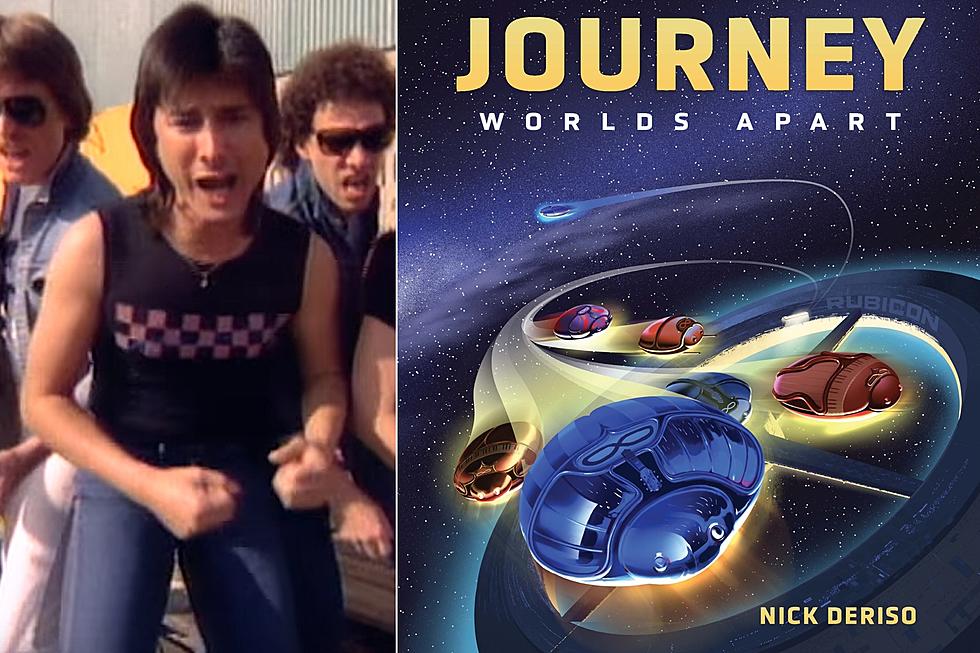
Why Journey Never Accepted the ‘Corporate Rock’ Tag: Book Excerpt
An expansive new biography of Journey is on the way from UCR assistant managing editor Nick DeRiso that promises to delve into "every era, every album and every tour."
Available for ordering now, 'Journey: Worlds Apart' features dozens of interviews with key contributors including Neal Schon, Gregg Rolie, Jonathan Cain, Steve Smith, Deen Castronovo, Steve Augeri and others. Among those offering wider perspective are collaborators like John Waite, Prairie Prince, Jeff Scott Soto, Marco Mendoza and Jan Hammer, as well as stalwart road manager Pat Morrow, former 'Rolling Stone' contributing editor David Wild, original MTV VJ Martha Quinn, album-cover artist Stanley Mouse, and Joel Selvin, the longtime San Francisco music writer who covered Journey almost from the beginning.
The group started as a dream for former Santana road manager Herbie Herbert, who thought he could build a blockbuster band out of the group's post-Woodstock remnants with Rolie and Schon. Turns out, he could – but it would take a few albums, and the arrival of frontman Steve Perry. When Rolie exited at the turn of the '80s, Journey was already a multi-platinum band – and they would only get bigger with the addition of Cain from Journey's former opening act, the Babys.
Then critics began describing Journey as "corporate rock." In the following excerpt from 'Journey: Worlds Apart,' DeRiso sorts through how that happened with Cain, Wild and others:
By the time Journey released Frontiers, they were as much a company as a band. Manager Herbie Herbert founded related subsidiaries to handle every aspect of their recording and touring operations. The vested members voted on major decisions board-room-style.
Then critics began using the label “corporate rock” as a cudgel against Journey.
Herbert was helping to rearrange the DNA of rock, bringing in business concepts to a culture that had essentially run on nothing more than sex, drugs and a few power chords. The members of Journey were partners in these commercial entities, but they weren’t equals. The vision, everyone openly admitted, was all Herbert’s.
“Not many managers started out as roadies, you know, and went through every phase of show business,” Jonathan Cain said. “Herbie had this extraordinary ability to start out as Neal Schon’s roadie and end up with a PA company, then a lighting company. Then he has this vision of video, and brings video into rock. He was an extraordinary man.”
Herbert delved into the finest details, like a shaggy-haired walking spreadsheet. Still, to some critics, it was all starting to sound more like Wall Street than Haight. A rising group of younger acts like the Ramones tried to push back, too.
Yet millions of record buyers, radio listeners, and concertgoers remained stubbornly immune to these criticisms. As decades passed, some of the same pundits would admit that they had treated the band unfairly. Time offered new perspectives.
“In that period between when I was like a young, asshole Rolling Stone writer trying to have whatever I perceived, rightly and wrongly, as credibility, I had a few experiences,” said David Wild, who later wrote the liner notes to the platinum-selling 2001 hits package The Essential Journey. He realized, for instance, that their album image choices tended to make Journey seem more faceless.
“I think there is something about the name, which seems generic and new age,” Wild said. “Like, did they ever have an album cover that had them on it? You know, the branding of it was like Yes in a different, earlier era. It was not a cult of personality; they weren’t cool with the cool crowd, for a large part of their career. There are just some bands that are more the people’s choice. But that being said, the longer I live, the more I respect people who were just simply great.”
Journey Ultimately Had the Last Laugh
Journey’s best-selling singles endured. Even songs that had not been huge hits found their place on movie soundtracks, TV shows, radio programs, and countless playlists. Genres rose and fell as time went on, even as a long-awaited critical evaluation led to Journey’s induction into the Rock & Roll Hall of Fame.
“You know, music went to flannel rock, it went to grunge rock. Rock ’n’ roll went through a lot of different phases,” Cain added. “But calling Journey corporate rock was just ridiculous because we just played a lot of shows. We wrote music that was all over the map — so did the Beatles. So what, you know? The critics just loved to hate Journey for a while. But I knew it was gonna be a passing phase, because the songs were mightier than their pen.”
The Best Song From Every Journey Album
Gallery Credit: Nick DeRiso
You Think You Know Journey?

